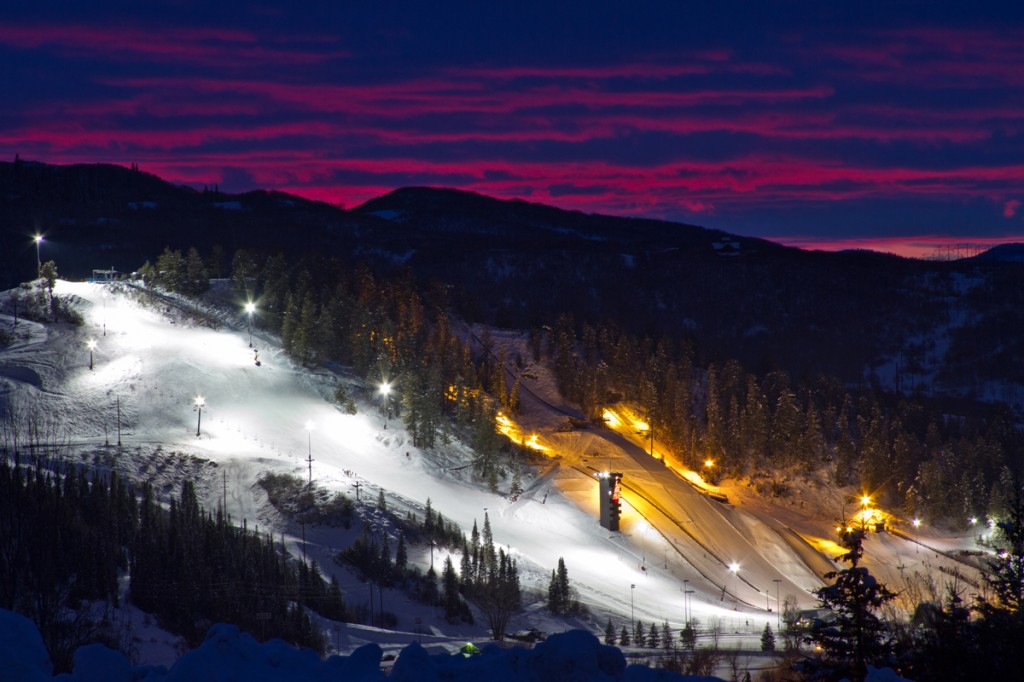 Howelsen Hill – One Colorado’s Oldest Ski Areas
Howelsen Hill – One Colorado’s Oldest Ski Areas
Picture taken in the Fish Creek Area by Charlie Dresen 1/14/2011
Dates of Operation: 1914 – Present
Area Statistics:
* Elevations: Summit 7,136 ft; Base 6,696; Vertical Drop 440 ft
* Terrain: 12 slopes, 37.5 degrees grade
* Ski Jumps, snowmaking, night skiing, alpine slide
Lifts: 1 Double chair, 1 Pomalift, 2 Magic Carpet conveyor lifts
* Season: December 15 – April 1
* Rates: 2011: $15.00 adult, $5 child
History:
By Bill Fetcher
Howelsen Hill, located across the Yampa River from downtown Steamboat Springs, and owned and operated by the city, has the distinction of being one of the country’s oldest ski areas in continuous use. It is the only ski area listed on the Colorado State Register of Historic Places. Over the decades nearly 70 Winter Olympians have trained on its slopes and jumps. Prior to its use as a ski hill it was the town’s Elk Park, a small wildlife preserve. And prior to the arrival of Norwegian skier Carl Howelsen in 1913, skiing was regarded only as a practical means of getting about in snow during Colorado’s long winters. Howelsen would introduce the sporting aspects of skiing to the populace with ski jumping and cross-country competitions. His influence would be felt throughout the Rocky Mountains. He made his home in a cabin in Strawberry Park just north of town and found work as a mason and bricklayer when not involved with skiing.
Early 1914 found Howelsen organizing the Steamboat Springs Winter Sports Club training program for youngsters, and the first Winter Carnival that featured a
ski jumping exhibition on Woodchuck Hill, site of the present Colorado Mountain College. Convinced that ski jumping records could be broken if he had a steeper
slope, he looked to the north-facing hill across the river that abutted Elk Park. That fall, trees and brush were cleared and a jump built, ready for the town’s
second Winter Carnival. The slope was named Howelsen Hill in 1917. The elk herd was relocated a few years later.
Howelsen Hill, with a vertical rise of only 440 feet, would remain a jumping hill through the 1920s when interest in the Alpine disciplines, slalom and downhill,
would surface. In 1931 a slalom course was cleared on the east flank of the hill and the first slalom events held.
The first lift on Howelsen Hill was a boat tow, built in 1934, nothing more than a sled pulled by cable to haul lumber and other construction materials up to repair
and maintain the jumps. By then there were two take-off platforms. Because this crude lift was found to be useable by skiers, in 1937 it was relocated and
extended to the top of Howelsen Hill and rebuilt as a double -reversible, or jigback,” with two ten-passenger sleds pulled by an electric winch at the base.
This homemade tow, with a length of 1000 feet and vertical rise of 440 feet, would see service till 1970.
In 1935 the first Winter Carnival Night Show, with torchlight parades, ski jumping through a fiery hoop and fireworks was presented on Howelsen Hill. The
following year would see the first “Lighted Man” spectacle. Night skiing was offered as early as 1937 and is still featured.
In 1945 a rope tow for beginners was built on Sulphur Cave Hill just west of the jumps. Work began on the base lodge: it was completed in 1946. Mechanisms
were in place, namely Steamboat’s skiing heritage, post-war optimism, and possible competition with two major Colorado areas, Aspen and Winter Park,
for this little ski area to consider expansion.
Construction of “The World’s Longest Single-Span Ski Lift” began in 1947. With a length of 8,850 feet and a vertical rise of 1,440 feet, it would pass over the top
of Howelsen Hill and continue to the summit of Emerald Mountain. It was built by the Mine and Smelter Supply Co. of Denver using patents by Ernest G. Constam,
Swiss inventor of the T-bar. The lift had 120 T-bars and 60 single chairs passing through 22 wooden, portal towers, all driven by a 75 hp electric motor at the
base. A handsome, log Tow House was built to house the lift’s drive machinery as well as the winch for the boat tow. The lift began service at the end of January
1948. The chairs were combined with the T-bars, two T-bars between each chair, for the lift’s opening season and the following 1948-’49 season. Beginning
that summer the chairs were only used for sightseers and would be replaced by the T-bars for ski season.
—For more on this topic or questions regarding real estate in Steamboat Springs, feel free to call Charlie at 970-846-6435 or write me an email at: charlie@steamboatsmyhome.com. I will answer your post or email promptly with candid and informed answers. Click here to view all properties in Steamboat Springs in “real time” — This is one of the few real estate sites showing all foreclosed and all short sale listings in real time and updated every few minutes.


Links
Steamboat Areas
Popular Searches
Broker Associate
Popular Searches
Didn't find what you were looking for?